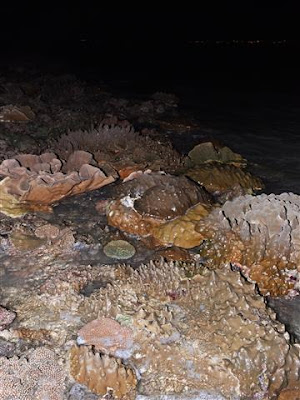We are back at this newly discovered shore of East Coast Park! Despite the fact that the shoreline of East Coast Park is reclaimed, we are always amazed at how life creeps back over time if we do not disturb them.
The most abundant hard coral on this stretch of reclaimed reef would be the Disk coral (Turbinaria sp.). There are also some Boulder Pore corals (Porites sp.) and Favid hard corals (Family Faviidae). However, this rock wall is not as thickly covered with corals as compared to the one we looked at last month.
At the deeper waters where the waves are not splashy, I noticed there are several of the white Sea whips (Junceella sp.).
While photographing another white sea whip sticking out of the water surface on a low tide, I realised later that there also a submerged red sea whip at the back!
As this is my second time, I decided not to be awe-struck with the hard corals and start keeping a lookout for reef associates. I saw many of these handsome Arabian cowries (Cypraea arabica).
The Reef octopuses were active at night and I stumbled upon many of them while negotiating the rocks of the sea wall.
This well camouflaged fish is known as the Painted scorpionfish (Parascorpaena picta). It is sometimes mistaken as stonefish.
I do not know the identity of this huge bivalve or clam though I think we have seen it elsewhere before.
Here's a look at the flesh within the two shells.
Cowries-wise, I only saw one Miliaris cowrie (Erosaria miliaris) and also only one Onyx cowrie (Erronea onyx).
Unfortunately, this stretch of rock wall has a freshly-laid driftnet. It was tied to a brick. Driftnets are detrimental to our marine habitat especially when they are abandoned because they trap all sorts of living organisms indiscriminately.
Walking down the rock wall, there are several more driftnets that are obviously abandoned based on the colour and encrustation on the nets.
These jammed-packed corals remind me of the reclaimed reefs of Tanah Merah though the latter has a higher diversity of hard corals.
This uncommon hard coral is the Horn corals (Hydnophora sp.) and they have distinctive conical bumps.
We explored yet another stretch of rock wall and found this zoanthids surprise! Don't you find that the zoanthids are very colourful?
This is because there are many of these Tiny red sea cucumbers (Family Cucumariidae) wedged in between the zoanthids! These sea cucumbers are not commonly sighted on our shores.
Here's a closer look at the pretty fish! I do not know its identity though.
Update: Thanks to Ron, the id for this blenny is Light's Rockskipper (Entomacrodus lighti). It grows to about 11cm long, and can be recognised by the series of dark vertical bars along its body and reticulate pattern on its head.
I decided to spend some time from the remaining low tide to look at the small stretches of sandy and seagrass shore and discovered tons of Brittle stars (Subclass Ophiuroidea) on the seagrass.
We were pleasantly surprised to discovered a thick patch of the rare Noodle seagrass (Syringodium isoetifolium)! East Coast is the first mainland shore that we have seen this species of seagrass.
The Noodle seagrass has tubular leaves much like a thick noodle! Unlike other seagrasses that are flat, noodle seagrass is circular in cross-section.Found lying among the seagrasses are several of the Tiny red sea cucumbers.
I came across one Frilly sea anemone (Phymanthus sp.) which is very commonly found on our southern shores.
Another solo animal that I saw would be this baby White sea urchin (Salmacis sp.) that we often see in our northern shores. They tend to carry stuffs on their spines as a form of camouflage.
There are many Haddon's carpet anemones (Stichodactyla haddoni) and some are home to the Five-spot anemone shrimps (Periclimines brevicarpalis).
There was even one Giant carpet anemone (Stichodactyla gigantea) which we do not see on East Coast.
It was nice to find the Spiny sea star (Gymnanthenea laevis). This sea star is a common resident many stretches of East Coast shore. Ria saw more sea stars on this trip!
Ending off the blog post, here's a special find of the day! This huge onch-looking slug is actually the Actinocyclus nudibranch (Actinocyclus sp.) that we seldom see on our shores.
More photos of the trip on my facebook album:
https://www.facebook.com/media/set/?set=a.10153414339573158.1073741881.547198157&type=1&l=c034d86c2a

































No comments:
Post a Comment